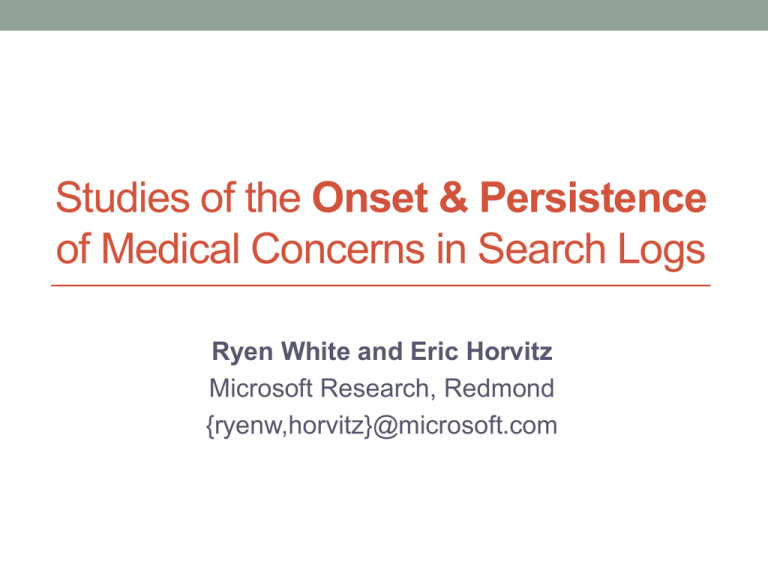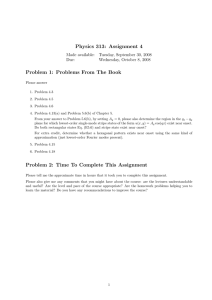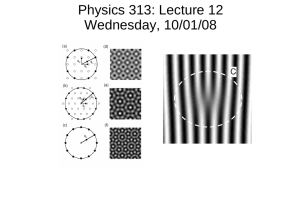Onset & Persistence of Medical Concerns in Search Logs Microsoft Research, Redmond
advertisement

Studies of the Onset & Persistence
of Medical Concerns in Search Logs
Ryen White and Eric Horvitz
Microsoft Research, Redmond
{ryenw,horvitz}@microsoft.com
Motivation
• People use the Web to diagnose and understand
medical conditions
• 80% of U.S. Web users perform medical search
(Pew, 2011)
• Studies to date have focused on the impact of the
Web on medical search
• Including cyberchondria (White & Horvitz, TOIS 2009) – Escalations in
concerns within a single session (e.g., [headache] [brain tumor])
• Search behavior over time reflects in-world events
such as professional diagnosis, etc. [Our Focus]
Our Focus: Logs as a Lens on Health
• We explore how medical concerns emerge over
time and how concerns persist post onset
• Long-term needed to understand medical search
• 60% of medical sessions start directly with a condition query
• Searchers come to search engines with a condition in mind!
• 95% of these sessions had medical query in prior session(s)
• Long-term helps us understand medical trajectories
• Predict emerging concerns, personalize search, guide healthcare use
• Note: Long-term may be influenced by external
events (e.g., diagnosis) – Web not always cause
Contributions
• Large-scale log analysis to:
1. Characterize how health-related concerns
emerge in search activity over time
2. Analyze persistence of concerns post onset,
including interruptions to future search tasks
3. Build models to predict condition onset,
escalations in concerns, and future interruptions
• Will focus on #1 and #2 in this talk
Data
• Anonymized toolbar logs from millions of users
• 3 month period from Jan – Mar 2011
• Extracted search sessions (30 min timeout)
• Included queries from Google, Yahoo!, Bing
• Assigned topical labels from ODP to URLs
• Content-based classifier
• Identify which URLs are medical
Long-Term Profile Generation
• Identify searchers with evidence of health seeking intent
• Searchers who visited at least one URL in Health category
• Removed outlier users
• 170k users, 25M sessions, 1B+ URLs
• 150 search sessions / user, spanning avg. of 76 days / user
• Automatically labeled queries based on:
• Symptoms: Merck medical dictionary + synonyms from click graph
• E.g., headache
• Benign explanations: ICD10 list + synonyms from click graph
• E.g., caffeine withdrawal
• Serious illnesses: ICD10 list + synonyms from click graph
• E.g., brain tumor
What are some key characteristics of the
long-term health-search profiles?
Medical Search Over Time
Statistic (n=169,513)
Mean
SD
# medical queries (based on clicks)
36.67
60.29
% queries medical
3.4%
4.3%
# medical sessions
37.04
32.05
# medical queries (wordlist method)
10.31
17.90
# queries with serious illnesses
4.60
8.68
# queries with benign explanations
1.86
5.81
# queries with symptoms
4.15
11.39
• 3% of queries are medical related
ODP classes
of SERP clicks
Dictionary lookup
Illness and
explanation
0.8%
• Users search more often for
symptoms and serious illnesses
than benign, common explanations
Symptom
and
explanation
1.1%
Benign
explanation
16.0%
Symptom
38.2%
Symptom
and illness
0.6% All
0.2%
Serious
illness
43.1%
What are characteristics of how
health-related concerns emerge
in activity over time?
Condition Onset
• Explore search behavior before the onset of the
first occurrence of a condition – randomly chosen
Pre-onset
Condition
Symptoms
Onset
condition
Q
q q
q q q
Post-onset
QQ
q
q
Time
• Pre-onset history can contain other conditions
• 83% searched for at most one other condition prior to onset
• 61% searched for no conditions pre-onset
• Also extracted behavior after the condition onset
• Overall: 159K pre-onset histories, one per user
Pre-Onset Behavior
• Extracted features of search behavior before onset
• We computed statistics of search behavior, e.g.,
• 20 medical search sessions over 49 days before condition
• 3% of user’s time online was spent viewing medical content
• Additionally, we wanted to check if onset condition and
the symptoms searched previously were related
• Extracted symptom-onset pairs, compared with known
• E.g., [headache] {migraine, caffeine withdrawal, brain tumor}
• 79.5% of prior symptoms were related to onset
• Emergence of conditions appears to extend back over time
Condition Severity
• Study the relationship between pre-onset and severity
• Many search / Web usage behaviors are similar, but …
Onset condition is …
Feature
Serious (n=117389)
Benign (n=34424)
% medical queries
3.0% (4.0%)
4.0% (4.2%)
# medical queries
5.30 (12.12)
7.69 (15.48)
# symptom queries
1.81 (6.43)
2.34 (7.58)
# condition queries
1.74 (5.36)
2.27 (6.36)
• Onset condition = benign, more medical searching
• Web may be contributing as a causal influence
• Users may be better informed and less likely to escalate
• Narrow lens of log analysis means that we cannot be sure why
Benign explanations
Serious illnesses
Number of symptom queries
Feature Trends
• Compute gradient of line of best fit
of the features over time before the
condition onset
Line of
best fit
q
Onset
condition
q q q
Time
Q
• Observations:
• Condition acuity increases top-to-bottom
• Benign explanations on bottom are acute
• e.g., food poisoning and panic attacks
• Serious illnesses on top are chronic
• e.g., chronic fatigue syndrome
asthma
dehydration
chronic fatigue syndrome
irritable bowel syndrome
eczema
bruise
cyst
pregnancy
angina
anxiety
heartburn
constipation
sleep apnea
epilepsy
muscular dystrophy
throat infection
bronchitis
urinary tract infection
malaria
sexually transmitted…
liver disease
anemia
migraine
myopathy
pneumonia
embolism
panic attack
heart failure
lymphoma
heart attack
meningitis
appendicitis
0.00 0.05 0.10 0.15 0.20 0.25 0.30
Average best-fit gradient
How do searches for the condition
persist following evidence
of initial concern onset?
Post-Onset Search Behavior
• Computed the same features for search behavior after
the onset condition rather than before
Feature
% URLs medical
% queries medical
% online time on medical pages
# unique symptoms
Symptom persistence (days)
Most people
# unique conditions
searched for zero
Condition persistence
(days)
conditions pre-onset
% or Avg (SD)
4.9%
4.2%
8.0%
0.50 (1.01)
2.46 (3.42)
1.04 (1.29)
7.57 (12.49)
% change from
pre-onset
+88.5
+31.3
+247.8
−20.6
−27.9
+40.5
+25.3
• Medical search increases, symptom searching decreases,
and condition searching increases (more focused)
Interruption: Effect of Health Concerns
• Suspension of ongoing search activity
• Given a search session, an interruption comprises at least
one search for the onset condition sandwiched between
two series of 1+ non-medical searches, e.g.,
Onset
condition
Q
Interruptions
Session
n Q n
n Q Q n n n
n
n n n
Time
• We show that interruption happens often:
• 30.3% of users were interrupted in this way
• 2.39 interruptions / user, totaling 2 hours and 16 mins. searching
• 6% of future search sessions interrupted, on 2.68 total days
Summary and Takeaways
Summary of Presented Findings
• 80% of pre-onset symptoms relate to onset condition
• True even though the search queries are weeks apart
• Medical search increases near to onset
• Related to acuity of condition
• Onset type is related to pre-onset behavior
• e.g., Benign explanations follow more medical searching
• Medical search behavior post-onset pre-onset
• e.g., Symptom search drops, condition search increases
• Post-onset interruptions occur frequently
Other Things (see paper for more info)
• Between-session escalations in medical concerns
(White & Horvitz, 2009)
(New in this paper)
• Focus-of-attention
• Users narrow focus over time – focus on particular conditions of interest
• Periodicities in medical search
• Medical search behavior is clustered, not spread out over time
• Accurate prediction of onset, escalation, interruption
Implications & Limitations
• Onset as cue to use previous clicks for related symptoms
• Use combination of symptoms searched over time to
estimate the onset condition (early warning signs!)
• Observed over time: [twitching], [twitching eye], [twitch], …
• Unobserved (yet!): [ALS] [Lou Gherig’s Disease]
• Given accurate prediction of:
• Onset: Adjust search experience based on severity or prevalence
• Escalation: Provide links to broader content (benign explanations)
• Interruptions: Provide support for more effective task switching
• Limitations of log analysis:
• Machines may be shared (not all queries from same user)
• Limited definitions of concepts (e.g., interruptions)
Conclusions
• Log-based longitudinal study of online health search
• Characterized aspects of that behavior before condition
onset – relationship with condition type, escalations
• Studied post-onset behavior and found differences in
search behavior, and evidence of interruptions
• Also built predictive models of onset, escalations, impact
• Search engines could mine long-term health seeking
behavior to provide better medical-search support






